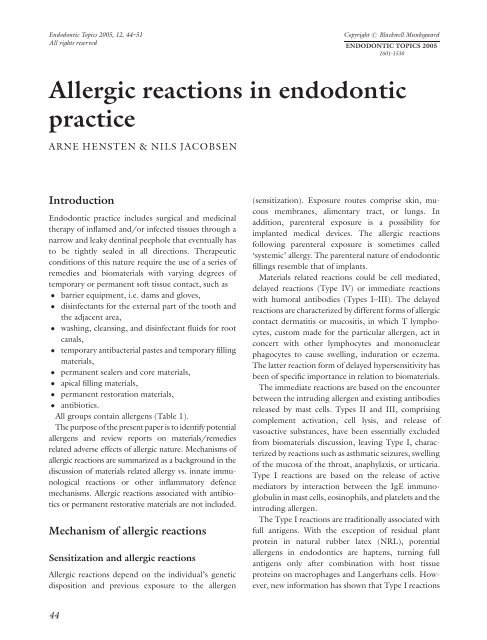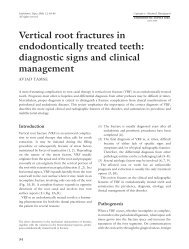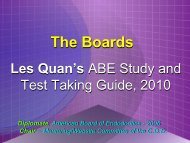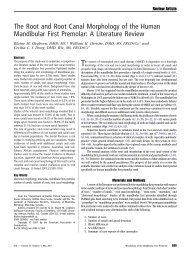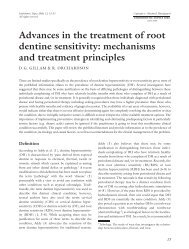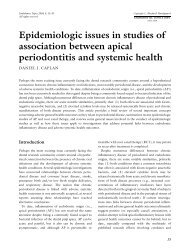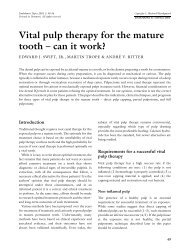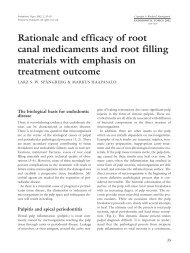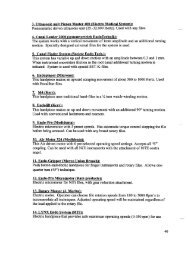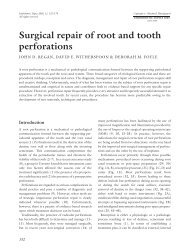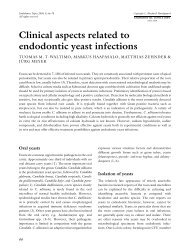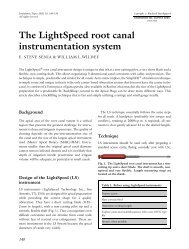Allergic reactions in endodontic practice - Wiley Online Library
Allergic reactions in endodontic practice - Wiley Online Library
Allergic reactions in endodontic practice - Wiley Online Library
Create successful ePaper yourself
Turn your PDF publications into a flip-book with our unique Google optimized e-Paper software.
Endodontic Topics 2005, 12, 44–51<br />
All rights reserved<br />
Copyright r Blackwell Munksgaard<br />
ENDODONTIC TOPICS 2005<br />
1601-1538<br />
<strong>Allergic</strong> <strong>reactions</strong> <strong>in</strong> <strong>endodontic</strong><br />
<strong>practice</strong><br />
ARNE HENSTEN & NILS JACOBSEN<br />
Introduction<br />
Endodontic <strong>practice</strong> <strong>in</strong>cludes surgical and medic<strong>in</strong>al<br />
therapy of <strong>in</strong>flamed and/or <strong>in</strong>fected tissues through a<br />
narrow and leaky dent<strong>in</strong>al peephole that eventually has<br />
to be tightly sealed <strong>in</strong> all directions. Therapeutic<br />
conditions of this nature require the use of a series of<br />
remedies and biomaterials with vary<strong>in</strong>g degrees of<br />
temporary or permanent soft tissue contact, such as<br />
barrier equipment, i.e. dams and gloves,<br />
dis<strong>in</strong>fectants for the external part of the tooth and<br />
the adjacent area,<br />
wash<strong>in</strong>g, cleans<strong>in</strong>g, and dis<strong>in</strong>fectant fluids for root<br />
canals,<br />
temporary antibacterial pastes and temporary fill<strong>in</strong>g<br />
materials,<br />
permanent sealers and core materials,<br />
apical fill<strong>in</strong>g materials,<br />
permanent restoration materials,<br />
antibiotics.<br />
All groups conta<strong>in</strong> allergens (Table 1).<br />
The purpose of the present paper is to identify potential<br />
allergens and review reports on materials/remedies<br />
related adverse effects of allergic nature. Mechanisms of<br />
allergic <strong>reactions</strong> are summarized as a background <strong>in</strong> the<br />
discussion of materials related allergy vs. <strong>in</strong>nate immunological<br />
<strong>reactions</strong> or other <strong>in</strong>flammatory defence<br />
mechanisms. <strong>Allergic</strong> <strong>reactions</strong> associated with antibiotics<br />
or permanent restorative materials are not <strong>in</strong>cluded.<br />
Mechanism of allergic <strong>reactions</strong><br />
Sensitization and allergic <strong>reactions</strong><br />
<strong>Allergic</strong> <strong>reactions</strong> depend on the <strong>in</strong>dividual’s genetic<br />
disposition and previous exposure to the allergen<br />
(sensitization). Exposure routes comprise sk<strong>in</strong>, mucous<br />
membranes, alimentary tract, or lungs. In<br />
addition, parenteral exposure is a possibility for<br />
implanted medical devices. The allergic <strong>reactions</strong><br />
follow<strong>in</strong>g parenteral exposure is sometimes called<br />
‘systemic’ allergy. The parenteral nature of <strong>endodontic</strong><br />
fill<strong>in</strong>gs resemble that of implants.<br />
Materials related <strong>reactions</strong> could be cell mediated,<br />
delayed <strong>reactions</strong> (Type IV) or immediate <strong>reactions</strong><br />
with humoral antibodies (Types I–III). The delayed<br />
<strong>reactions</strong> are characterized by different forms of allergic<br />
contact dermatitis or mucositis, <strong>in</strong> which T lymphocytes,<br />
custom made for the particular allergen, act <strong>in</strong><br />
concert with other lymphocytes and mononuclear<br />
phagocytes to cause swell<strong>in</strong>g, <strong>in</strong>duration or eczema.<br />
The latter reaction form of delayed hypersensitivity has<br />
been of specific importance <strong>in</strong> relation to biomaterials.<br />
The immediate <strong>reactions</strong> are based on the encounter<br />
between the <strong>in</strong>trud<strong>in</strong>g allergen and exist<strong>in</strong>g antibodies<br />
released by mast cells. Types II and III, compris<strong>in</strong>g<br />
complement activation, cell lysis, and release of<br />
vasoactive substances, have been essentially excluded<br />
from biomaterials discussion, leav<strong>in</strong>g Type I, characterized<br />
by <strong>reactions</strong> such as asthmatic seizures, swell<strong>in</strong>g<br />
of the mucosa of the throat, anaphylaxis, or urticaria.<br />
Type I <strong>reactions</strong> are based on the release of active<br />
mediators by <strong>in</strong>teraction between the IgE immunoglobul<strong>in</strong><br />
<strong>in</strong> mast cells, eos<strong>in</strong>ophils, and platelets and the<br />
<strong>in</strong>trud<strong>in</strong>g allergen.<br />
The Type I <strong>reactions</strong> are traditionally associated with<br />
full antigens. With the exception of residual plant<br />
prote<strong>in</strong> <strong>in</strong> natural rubber latex (NRL), potential<br />
allergens <strong>in</strong> <strong>endodontic</strong>s are haptens, turn<strong>in</strong>g full<br />
antigens only after comb<strong>in</strong>ation with host tissue<br />
prote<strong>in</strong>s on macrophages and Langerhans cells. However,<br />
new <strong>in</strong>formation has shown that Type I <strong>reactions</strong><br />
44
<strong>Allergic</strong> <strong>reactions</strong> <strong>in</strong> <strong>endodontic</strong> <strong>practice</strong><br />
Table 1. Some current materials and remedies <strong>in</strong> <strong>endodontic</strong>s and their allergenic potential (9–12)<br />
Area of application Chemical group Allergenic potential<br />
Barrier equipment Natural rubber latex 1<br />
Residual prote<strong>in</strong>s and chemical additives 1<br />
Polyisoprene<br />
Surface dis<strong>in</strong>fectants Hydrogen peroxide (30%)<br />
T<strong>in</strong>cture of iod<strong>in</strong>e (5%) 1<br />
Chlorhexid<strong>in</strong>e (0.5%) 1<br />
Dis<strong>in</strong>fectants for root canals Phenol and derivatives 1<br />
Aldehydes 1<br />
Potassium iodide (2%)<br />
Benzalkonium chloride (0.1–1.0%) 1<br />
Chloram<strong>in</strong>e 1<br />
Sodium hypochlorite (Dak<strong>in</strong>’s solution, 0.5–1.0%) 1<br />
Temporary antibacterial paste<br />
Calcium hydroxide<br />
Temporary fill<strong>in</strong>g materials ZnOE and ZnOE modified with alum<strong>in</strong>a, natural res<strong>in</strong>, or PMMA 1<br />
Sealers<br />
Chloroform, for chloropercha (earlier)<br />
Salicylate, with calcium hydroxide<br />
ZnOE formulas with thymol, Peru balsam, colophony, formaldehyde<br />
releas<strong>in</strong>g pastes (Endomethazone, N2)<br />
1<br />
Polyketone liquid with ZnO conta<strong>in</strong><strong>in</strong>g 0.5% dichlorophene 1<br />
Epoxy res<strong>in</strong>, with bismuth, tetraam<strong>in</strong>e, silver, titanium dioxide <strong>in</strong><br />
bisphenol-A-diglycidylether monomer (AH26, AHPlus)<br />
1<br />
Glass ionomers<br />
Core materials Gutta-percha. Natural 1,4-isoprene polymer ?<br />
Silver 1<br />
Apical fill<strong>in</strong>g materials<br />
Amalgam<br />
Glass ionomers<br />
Calcium chelate/polyv<strong>in</strong>yl res<strong>in</strong> (Diaket)<br />
M<strong>in</strong>eral trioxide aggeregates<br />
Gutta percha ?<br />
ZnOE 1<br />
Composite res<strong>in</strong>s 1<br />
45
Hensten & Jacobsen<br />
may also be elicited by haptenic substances, such as<br />
metal ions (1), leav<strong>in</strong>g the border between cell<br />
mediated delayed <strong>reactions</strong> and immediate humoral<br />
reaction less simple.<br />
Implant allergy, a parallel to <strong>endodontic</strong>s?<br />
Case reports <strong>in</strong>dicate that loosen<strong>in</strong>g or other dysfunction<br />
of metallic implants may be related to Type IV<br />
metal allergy (2) or allergy to components <strong>in</strong> the bone<br />
cement (3), as revealed by patch tests. These <strong>reactions</strong><br />
are sometimes accompanied by allergic contact dermatitis<br />
and urticara and are considered to be the result of<br />
previous sensitization, although the opposite mechanism<br />
has not been excluded from the discussion: metal<br />
sensitization by gr<strong>in</strong>d<strong>in</strong>g parts of a loosen<strong>in</strong>g implant<br />
(4). The observed allergic side effects <strong>in</strong> <strong>endodontic</strong>s<br />
are similar dermal <strong>reactions</strong> and, as has been speculated,<br />
local tissue <strong>reactions</strong> <strong>in</strong>hibit<strong>in</strong>g apical heal<strong>in</strong>g (5).<br />
Allergen exposure conditions<br />
<strong>Allergic</strong> <strong>reactions</strong> require contact with host tissue cells<br />
outside the m<strong>in</strong>eralized dent<strong>in</strong>e, able to supplement<br />
the haptens with specific prote<strong>in</strong>s, and to provide<br />
transport to immunocompetent organs. The direct soft<br />
tissue contact is limited to the tooth apex or accessory<br />
root canals, impart<strong>in</strong>g strict quantitative limitations,<br />
although retrograde fill<strong>in</strong>g or apical overfill <strong>in</strong>crease the<br />
contact area considerably. In addition, passage of<br />
solutes through dent<strong>in</strong>al tubules cannot be disregarded<br />
dur<strong>in</strong>g debridement procedures and by leakage from<br />
the <strong>endodontic</strong> fill<strong>in</strong>g (6). In vitro experiments have<br />
shown that dent<strong>in</strong>al tubules are pathways for liquid<br />
transport, an <strong>in</strong>tact and well-m<strong>in</strong>eralized acellular root<br />
cement probably represent<strong>in</strong>g an important barrier<br />
<strong>in</strong> vivo.<br />
However, the anatomical structure <strong>in</strong> the apical<br />
region shows marked variations such as irregular<br />
primary tubules and accessory root canals (7), represent<strong>in</strong>g<br />
a challenge dur<strong>in</strong>g <strong>endodontic</strong> therapy as well<br />
as <strong>in</strong>creas<strong>in</strong>g the possibility of soft tissue exposure for<br />
potential allergens. The cellular and less m<strong>in</strong>eralized<br />
cement located to this part of the tooth probably does<br />
not represent a barrier. For similar reasons the furcature<br />
region of multirooted teeth should not be overlooked.<br />
Moreover, the ‘on site’ production of the <strong>endodontic</strong><br />
fill<strong>in</strong>g renders an amorphous product different from<br />
prefabricated implants with regard to physical structure<br />
and surface characteristics. Surface characteristics are<br />
important for the bioreaction of all implant materials<br />
(8), and the rough surface of the <strong>endodontic</strong> implant<br />
facilitates degradation and leakage of material components.<br />
In summary, m<strong>in</strong>ute quantities of chemical substances<br />
associated with <strong>endodontic</strong> therapy may establish<br />
contact with immunocompetent host tissue,<br />
particularly <strong>in</strong> the apical region. It is unclear whether<br />
dent<strong>in</strong>al transport of allergen-conta<strong>in</strong><strong>in</strong>g chemicals<br />
results <strong>in</strong> soft tissue contact <strong>in</strong> vivo. Inadvertent<br />
mucosal exposure and <strong>in</strong>halation of volatile fluids are<br />
contact possibilities outside the apical/dent<strong>in</strong>al area.<br />
Potential allergens <strong>in</strong> <strong>endodontic</strong>s<br />
Table 1 summarizes ma<strong>in</strong> <strong>endodontic</strong> materials and<br />
medicaments on the basis of current teach<strong>in</strong>g <strong>in</strong> the<br />
Scand<strong>in</strong>avian countries (9–11). A majority of the<br />
<strong>in</strong>gredients are adaptations of substances used <strong>in</strong><br />
general dentistry or medic<strong>in</strong>e. Their allergenic potential<br />
is based on empirical <strong>in</strong>formation from case reports<br />
and from animal experiments (12, 13). One characteristic<br />
difference as compared with general dentistry, is<br />
the absence of metal alloys conta<strong>in</strong><strong>in</strong>g nickel, gold,<br />
chromium or cobalt compris<strong>in</strong>g a majority of the<br />
allergic <strong>reactions</strong> (14). Exclud<strong>in</strong>g <strong>endodontic</strong> <strong>in</strong>struments,<br />
metal alloys are limited to silver core materials<br />
and amalgam for retrograde fill<strong>in</strong>g. In addition, heavy<br />
metal salts may be present <strong>in</strong> sealer or core materials for<br />
radioopacity purposes.<br />
Barrier equipment<br />
Good <strong>endodontic</strong> <strong>practice</strong> requires strict demands for<br />
isolation and dis<strong>in</strong>fection of the oral work<strong>in</strong>g environment.<br />
NRL <strong>in</strong> dams or gloves conta<strong>in</strong>s allergens of<br />
different types. Of these, residual latex prote<strong>in</strong>s may<br />
elicit immediate IgE based <strong>reactions</strong>, affect<strong>in</strong>g throat<br />
and airways or giv<strong>in</strong>g anaphylactic symptoms <strong>in</strong><br />
sensitized <strong>in</strong>dividuals. In addition, chemicals from the<br />
production process may act as haptens and give delayed<br />
dermal or mucosal <strong>reactions</strong> (15).<br />
Dis<strong>in</strong>fectants and antibacterials<br />
T<strong>in</strong>cture of iod<strong>in</strong>e and chlorhexid<strong>in</strong>e are potential<br />
haptens, but allergic <strong>reactions</strong> are uncommon, particularly<br />
for chlorhexid<strong>in</strong>e, although long-term, repeated<br />
46
<strong>Allergic</strong> <strong>reactions</strong> <strong>in</strong> <strong>endodontic</strong> <strong>practice</strong><br />
ulcer treatment has given immediate <strong>reactions</strong> (12).<br />
Classical antimicrobials such as camphorated phenols,<br />
formocresol, and cresat<strong>in</strong> are all allergenic substances,<br />
together with formaldehyde, but are now replaced by<br />
the quaternary ammonium compound benzalconium<br />
choride, or chloram<strong>in</strong>e. These compounds are rare<br />
sensitizers, although a moderate sensitizer, chloram<strong>in</strong>e<br />
may produce immediate contact <strong>reactions</strong>. <strong>Allergic</strong><br />
<strong>reactions</strong> associated with sodium hypochlorite (modified<br />
Dak<strong>in</strong>s solution) are uncommon, but have been<br />
reported (16). The surface dis<strong>in</strong>fectant hydrogen<br />
peroxide and the temporary antibacterial paste calcium<br />
hydroxide are not allergenic remedies.<br />
Temporary fill<strong>in</strong>g materials<br />
Temporary fill<strong>in</strong>g materials are <strong>in</strong>cluded <strong>in</strong> the present<br />
survey for two reasons: their content of recognized<br />
sensitizers and their possibility of mucosal contact after<br />
barrier removal. Eugenol is allergenic, temporary<br />
ZnOE formulations be<strong>in</strong>g responsible for 1/6 of<br />
perceived side effects <strong>in</strong> prosthodontics (17). Natural<br />
res<strong>in</strong>s, such as colophony, and methacrylate monomers<br />
are also allergens.<br />
Sealers<br />
The organic solvent chloroform used earlier with guttapercha<br />
(chloropercha) is irritant and toxic, but allergic<br />
<strong>reactions</strong> are not seen. Salicylate with calcium hydroxide<br />
is also <strong>in</strong>ert, whereas the group of sealers made up<br />
of ZnOE supplemented with Peru balsam, colophony,<br />
or thymol is a composite of recognized allergens.<br />
Formaldehyde released by Endometazone and N2 <strong>in</strong><br />
this group of sealers adds to their allergenic potential.<br />
Polyketone sealers, based on propionylactophenone<br />
monomer chelat<strong>in</strong>g with Zn <strong>in</strong> ZnO conta<strong>in</strong>s some<br />
dichlorophene, which is allergenic. Epoxy-res<strong>in</strong> sealers<br />
are based on the allergenic bisphenol A-diglycidylether<br />
(badge) and may conta<strong>in</strong> silver, bismuth and titanium<br />
dioxide, but releases less formaldehyde than the ZnOE<br />
sealers. Glass ionomers are not allergenic.<br />
Core materials and apical fill<strong>in</strong>g materials<br />
In pr<strong>in</strong>ciple, silver ions are allergens. Silver cones as core<br />
material are subject to corrosive <strong>reactions</strong>, but allergic<br />
<strong>reactions</strong> have not been reported. Gutta-percha is still<br />
the preferred core material because of its physical and<br />
chemical characteristics. The natural gutta-percha is a<br />
1,4-isoprene polymer available <strong>in</strong> a and b forms. The b<br />
form is used <strong>in</strong> the cones together with ZnO and<br />
barium sulphates for radioopacity. Other additives are<br />
pigments and colophony. Gutta-percha is considered<br />
non-allergenic. However, cross-reaction with NRL has<br />
been suggested (see below).<br />
The apical fill<strong>in</strong>g materials <strong>in</strong>clude traditional items<br />
such as amalgam, gutta-percha, and ZnOE cements<br />
modified with alum<strong>in</strong>a and res<strong>in</strong>s. In addition, glassionomers,<br />
ZnO/calcium sulphate, calcium chelate/<br />
polyv<strong>in</strong>yl res<strong>in</strong> or m<strong>in</strong>eral trioxide aggregates are used.<br />
Other retrograde fill<strong>in</strong>g materials conta<strong>in</strong> methacrylates<br />
such as BISGMA/TEGDMA. ZnOE cements and<br />
res<strong>in</strong>-based materials <strong>in</strong> this group are well-known<br />
allergens.<br />
General comments on potential allergens<br />
The stock of substances <strong>in</strong> <strong>endodontic</strong> <strong>practice</strong> changes<br />
with the development of new materials and discard<strong>in</strong>g<br />
of old. Devitaliz<strong>in</strong>g agents conta<strong>in</strong><strong>in</strong>g arsenic, phenol,<br />
or coca<strong>in</strong>e etc. have been discarded together with old<br />
fill<strong>in</strong>g materials such as asphalt, phenols, creosote and<br />
others. Many of these substances had their parallels <strong>in</strong><br />
<strong>in</strong>dustry and represented an allergenic as well as an<br />
environmental hazard. Revis<strong>in</strong>g the <strong>endodontic</strong> armamentarium<br />
is not a synchronized activity. The selection<br />
of <strong>in</strong>gredients presented <strong>in</strong> Table 1 is therefore a<br />
composite of new and old items, most of them be<strong>in</strong>g<br />
allergens.<br />
To our knowledge, there are no prevalence studies<br />
aimed specifically at allergic <strong>reactions</strong> <strong>in</strong> <strong>endodontic</strong><br />
<strong>practice</strong>. Questionnaire studies on adverse <strong>reactions</strong><br />
associated <strong>in</strong> other branches of dentistry have <strong>in</strong>dicated<br />
a maximum frequency of 1 <strong>in</strong> 300 orthodontic patients,<br />
<strong>in</strong>clud<strong>in</strong>g allergic as well as irritative <strong>reactions</strong> (18).<br />
This has been expla<strong>in</strong>ed by the use of base-metal alloys<br />
and by the dermal exposure of extraoral appliances <strong>in</strong><br />
addition to the mucosal exposure. It is accepted that<br />
dermal exposure, particularly to metallic allergens, is<br />
more likely to elicit allergic <strong>reactions</strong> than, e.g. the<br />
mucosal exposure. The prevalence of allergic <strong>reactions</strong><br />
<strong>in</strong> <strong>endodontic</strong>s is assumed to be considerably lower. A<br />
possible explanation could be that the exposure area is<br />
small and limited to the parenteral route and that the<br />
strongly allergenic metal ions are absent. On the other<br />
hand, antibacterial remedies <strong>in</strong> the root canal represent<br />
an exposure mode for potential allergens not associated<br />
47
Hensten & Jacobsen<br />
with other dental treatment. This fact is reflected <strong>in</strong> case<br />
reports on allergic <strong>reactions</strong>.<br />
Case reports and experiences<br />
As <strong>in</strong>dicated above, <strong>endodontic</strong> <strong>practice</strong> <strong>in</strong>cludes the<br />
application of allergens <strong>in</strong> several steps of the treatment<br />
procedure. S<strong>in</strong>ce substances <strong>in</strong> dental materials are not<br />
exclusive to dentistry, a certa<strong>in</strong> percentage of patients<br />
undergo<strong>in</strong>g <strong>endodontic</strong> therapy will have an acquired<br />
allergy for one or more of these substances. The<br />
majority of case reports on this subject are concerned<br />
with the use of formaldehyde <strong>in</strong> dis<strong>in</strong>fectants or<br />
devitaliz<strong>in</strong>g pastes. Other reports <strong>in</strong>clude <strong>reactions</strong> to<br />
epoxy or other res<strong>in</strong>-based materials <strong>in</strong> root-canal sealers<br />
or <strong>in</strong> retrograde fill<strong>in</strong>gs, or <strong>reactions</strong> associated with<br />
NRL as barrier equipment. In addition, some authors<br />
discuss the possibility of cross-<strong>reactions</strong> between NRLfactors<br />
and the chemically similar gutta-percha.<br />
Formaldehyde<br />
Formaldehyde (formol, formal<strong>in</strong>, trioxymethylene) is a<br />
recognized allergen able to provoke gastroenteric,<br />
respiratory and dermatological <strong>reactions</strong>. Immediate<br />
<strong>reactions</strong> <strong>in</strong> the form of rh<strong>in</strong>itis, asthma, urticaria, and<br />
anaphylaxis are also seen. A 57-year-old male developed<br />
a generalized itchy sk<strong>in</strong> rash and <strong>in</strong>tense facial swell<strong>in</strong>g<br />
after application of endomethasone, which conta<strong>in</strong>s<br />
paraformaldehyde. X-rays showed apical overfill. An<br />
allergic etiology was suspected on the basis of anamnestic<br />
<strong>in</strong>formation, but patch test proved negative (19).<br />
A 41-year-old male patient, undergo<strong>in</strong>g <strong>endodontic</strong><br />
treatment <strong>in</strong> the form of debridement of an <strong>in</strong>fected<br />
root canal and placement of a sealer, experienced a life<br />
threaten<strong>in</strong>g anaphylactic reaction (20). Allergy tests<br />
revealed a strong positive reaction to the formol part of<br />
the sealer, with <strong>in</strong>creased IgE plasma concentration. It<br />
was argued that a considerable apical overfill <strong>in</strong>itiated<br />
the reaction.<br />
Kunisada et al. (21) described wheal and flare of the<br />
entire body comb<strong>in</strong>ed with systemic symptoms such as<br />
whees<strong>in</strong>g, cough, dyspnoea <strong>in</strong> a 50-year-old woman,<br />
who was subjected to <strong>endodontic</strong> treatment with a<br />
dis<strong>in</strong>fectant conta<strong>in</strong><strong>in</strong>g paraformaldehyde. Diagnostic<br />
tests <strong>in</strong>dicated IgE dependent immediate <strong>reactions</strong>, as<br />
well as delayed <strong>reactions</strong>. These authors also analyzed<br />
15 other published cases of anaphylaxis and urticaria<br />
follow<strong>in</strong>g root-canal treatment with a formaldehyde<br />
dis<strong>in</strong>fectant, about half of which showed positive patch<br />
tests. Braun et al. (22) later reported anaphylactic shock<br />
<strong>in</strong> four <strong>endodontic</strong> patients, and generalized urticaria<br />
<strong>in</strong> three others associated with formaldehyde. Their<br />
review conta<strong>in</strong>ed 36 cases, partly overlapp<strong>in</strong>g the<br />
previous authors.<br />
On the basis of these reports, it is fairly well<br />
established that formaldehyde may lead to allergic<br />
<strong>reactions</strong> after <strong>endodontic</strong> treatment. The reaction<br />
pattern <strong>in</strong>dicates an immediate type of allergy, although<br />
delayed reaction could not be excluded. Accord<strong>in</strong>g to<br />
Braun et al. (22) the delayed <strong>reactions</strong> could be<br />
expla<strong>in</strong>ed by cont<strong>in</strong>ued leakage of formaldehyde<br />
through dent<strong>in</strong>al tubules or from an apical overfill.<br />
Patch tests were <strong>in</strong>conclusive.<br />
Epoxy and other res<strong>in</strong>s<br />
An early observation of epoxy allergy was published <strong>in</strong><br />
1976, describ<strong>in</strong>g a reaction to the <strong>endodontic</strong> material<br />
AH26, giv<strong>in</strong>g pa<strong>in</strong> <strong>in</strong> the apical area, accompanied by<br />
facial erythema after repeated <strong>endodontic</strong> treatment<br />
(23). Patch tests <strong>in</strong>dicated that the liquid <strong>in</strong>gredient, i.e.,<br />
the bisphenolglycidyl ether, is the allergen. Another<br />
report described mental nerve paresthesia caused by<br />
direct pulp capp<strong>in</strong>g with a HEMA- and TEGDMAbased<br />
restorative system. Patch tests revealed contact<br />
dermatitis for several methacrylates. It was speculated<br />
that sensitization could have taken place by repeated<br />
previous dental treatment (24). However, large cl<strong>in</strong>ical<br />
studies by Danish authors with dent<strong>in</strong>e bond<strong>in</strong>g<br />
composite res<strong>in</strong>s as root end sealant have not <strong>in</strong>dicated<br />
allergic responses <strong>in</strong> cases of failed heal<strong>in</strong>g (25, 26).<br />
Sodium hypochlorite<br />
Sodium hypochlorite allergy among dental patients<br />
may occur follow<strong>in</strong>g previous contact with household<br />
bleach (27). ‘Non-allergic hypersensitivity’ to the<br />
hypochlorite is another possibility (28). <strong>Allergic</strong> <strong>reactions</strong><br />
after root canal irrigation have been reported<br />
(29), but more concern has been expressed for other<br />
complications after <strong>in</strong>advertent <strong>in</strong>jection of sodium<br />
hypochlorite <strong>in</strong>to apical tissue (30).<br />
NRL and gutta-percha<br />
Similar to other branches of dentistry, allergic contact<br />
dermatitis due to NRL <strong>in</strong> dams or gloves are seen among<br />
48
<strong>Allergic</strong> <strong>reactions</strong> <strong>in</strong> <strong>endodontic</strong> <strong>practice</strong><br />
<strong>endodontic</strong> patients. In addition, case reports <strong>in</strong>dicate<br />
allergic <strong>reactions</strong> of Type I after treatment of patients<br />
who were hypersensitive to NRL us<strong>in</strong>g the guttapercha/chlororform<br />
technique (31, 32). Persist<strong>in</strong>g<br />
discomfort and urticarial symptoms necessitated removal<br />
of the root fill<strong>in</strong>gs after which the symptoms<br />
resolved. Cutaneous tests showed an extreme irritant<br />
reaction to gutta-percha dissolved <strong>in</strong> chloroform (32). It<br />
was argued that the phenomenon could be expla<strong>in</strong>ed by<br />
a cross-reaction between the NRL-product of the Hevea<br />
brasiliensis tree (cis-1,4-polyisoprene) and the guttapercha<br />
(trans-1,4-polyisoprene) of the Palaquium tree.<br />
However, commercial products of NRL and guttapercha<br />
are both subject to many steps of chemical<br />
treatment leav<strong>in</strong>g residual chemicals and not only<br />
residual plant prote<strong>in</strong>s. Moreover, the gutta-percha<br />
cones conta<strong>in</strong> z<strong>in</strong>c oxide, heavy-metal sulphates, waxes,<br />
res<strong>in</strong>s and pigments. Attempts to demonstrate cross<strong>reactions</strong><br />
between commercial gutta-percha and NRL<br />
products by advanced immunological laboratory methods<br />
have not been successful (33), although there were<br />
<strong>in</strong>dications that raw gutta-percha and raw NRL may<br />
show some cross-reactivity. This is similar to the fact<br />
that antibodies to chit<strong>in</strong>ases of ficus plants, avocados<br />
and bananas may be present <strong>in</strong> patients with Type I<br />
allergy to NRL.<br />
In summary, although gutta-percha is not considered<br />
a liability <strong>in</strong> <strong>endodontic</strong> <strong>practice</strong>, it is advised to be<br />
aware of the <strong>in</strong>creased possibility of allergic <strong>reactions</strong> to<br />
materials and remedies among patients with multiple<br />
allergies, <strong>in</strong>clud<strong>in</strong>g NRL allergy.<br />
<strong>Allergic</strong> sensitization by <strong>endodontic</strong><br />
treatment?<br />
Case reports followed by immunological test<strong>in</strong>g<br />
showed that allergic <strong>reactions</strong> follow<strong>in</strong>g <strong>endodontic</strong><br />
procedures may take place among previously sensitized<br />
patients. However, could patients be sensitized by<br />
<strong>endodontic</strong> treatment? Braun et al. (22) present<br />
<strong>in</strong>terest<strong>in</strong>g arguments for the possibility of sensitization<br />
to formaldehyde by repeated <strong>endodontic</strong> treatment,<br />
on the basis of contact with immunocompetent<br />
tissues <strong>in</strong> the adjacent apical region. However, valid<br />
evidence for sensitization beyond cl<strong>in</strong>ical observations<br />
has been difficult to provide.<br />
Attempts to f<strong>in</strong>d experimental evidence have <strong>in</strong>dicated<br />
an altered immunologic response to sealers <strong>in</strong><br />
root fill<strong>in</strong>gs after primary immunization by <strong>in</strong>jection of<br />
sealer/pulp tissue extracts <strong>in</strong>to dogs’ lymph nodes<br />
(34). This rationale was based on the assumption that<br />
sealer haptens comb<strong>in</strong>e with residual pulp tissue<br />
prote<strong>in</strong>s to form allergens. The <strong>reactions</strong> to positive<br />
control experiments, plac<strong>in</strong>g sheep erythrocytes (recognized<br />
antigens) <strong>in</strong> empty pulp chambers, was<br />
<strong>in</strong>terpreted as evidence of the ability of elicit<strong>in</strong>g<br />
immunologic <strong>reactions</strong> via the root canal, but did not<br />
really provide evidence for primary sensitization by this<br />
route. These observations are <strong>in</strong> accordance with<br />
<strong>in</strong>formation from early <strong>in</strong>vestigations show<strong>in</strong>g no<br />
positive patch tests to strong antigens such as<br />
formaldehyde, cresol, and eugenol <strong>in</strong> children after<br />
multiple formocresol pulpotomized primary teeth<br />
(35). A fair attitude to this question at the present<br />
time is that sensitization of the non-allergic patient by<br />
the <strong>endodontic</strong> material is unlikely, whereas an overt<br />
reaction <strong>in</strong> a previously sensitized <strong>in</strong>dividual is possible.<br />
Conclud<strong>in</strong>g remarks<br />
Endodontic <strong>practice</strong> <strong>in</strong>cludes short-time application of<br />
a series of allergenic chemicals, and permanent placement<br />
of <strong>in</strong> situ produced implants with physical<br />
properties liable to dissolution and leakage. As <strong>in</strong> other<br />
branches of dentistry, a certa<strong>in</strong> percentage of patients<br />
will be sensitized to one or more of these <strong>in</strong>gredients,<br />
which are often present <strong>in</strong> other products of everyday<br />
life. The apparently low prevalence of adverse effects<br />
associated with <strong>endodontic</strong> <strong>practice</strong> could be expla<strong>in</strong>ed<br />
by three factors: the small apical exposure area, the<br />
limited possibility for passage through dent<strong>in</strong>e, and the<br />
absence of important allergens characteristic of general<br />
dentistry, such as metal ions.<br />
The most frequent and most severe <strong>reactions</strong> have<br />
been observed after application of strong, watersoluble<br />
allergens such as formaldehyde and sodium<br />
hypochlorite, but allergic <strong>reactions</strong> to methacrylate<br />
sealers have also been observed. The case reports<br />
<strong>in</strong>dicate that both immediate and delayed immune<br />
<strong>reactions</strong> may take place. Proven allergic <strong>reactions</strong> have<br />
been systemic, i.e. giv<strong>in</strong>g allergic symptoms unrelated<br />
to the exposure site. Suspected local <strong>reactions</strong> <strong>in</strong> the<br />
form of fail<strong>in</strong>g <strong>endodontic</strong> therapy, similar to implant<br />
failure, have been difficult to prove and must be<br />
characterized as a still unresolved question.<br />
Understandable concern has been paid to the<br />
possibility of cross-reaction between NRL and the core<br />
49
Hensten & Jacobsen<br />
material gutta-percha, because NRL allergy is fairly<br />
common. Although there is no direct immunological<br />
evidence of a real cross-reaction between commercial<br />
products derived from these sources, a series of residual<br />
allergens associated with the production process may<br />
have common components. It is therefore wise to take<br />
all precautions <strong>in</strong> <strong>endodontic</strong> treatment of such<br />
patients. In general, clarification of exist<strong>in</strong>g allergies is<br />
important <strong>in</strong> <strong>endodontic</strong>s as <strong>in</strong> other branches of<br />
surgical <strong>in</strong>terventions.<br />
In conclusion, <strong>endodontic</strong>s represent an important<br />
part of dental therapy with very limited risk of<br />
provok<strong>in</strong>g allergic <strong>reactions</strong> associated with materials<br />
and remedies, although many <strong>in</strong>gredients are classified<br />
as allergens.<br />
References<br />
1. Hostynek JJ. Aspects of nickel allergy: epidemiology,<br />
etiology, immnune <strong>reactions</strong>, prevention, and therapy.<br />
In: Hostynek JJ, Maibach HI, eds. Nickel and the Sk<strong>in</strong>.<br />
Absorption, Immunology, Epidemiology and Metallurgy<br />
(Chapter 1). Boca Raton: CRC Press, 2002: 1–38.<br />
2. Thomas P. Allergien durch Implantwerktoffe. Orthopäde<br />
2003: 32: 60–64.<br />
3. Haddad FS, Levell NJ, Dowd PM, Cobb AG, Bentley<br />
G. Cement hypersensitivity: a cause of aseptic loosen<strong>in</strong>g?<br />
J Bone Jt Surg 1995: 129–130.<br />
4. Davis MDP, Wowad CM, She<strong>in</strong>man P. Orthopedic<br />
Prosthesis: is there any po<strong>in</strong>t <strong>in</strong> patch test<strong>in</strong>g? Dermatitis<br />
2004: 15: 210–212.<br />
5. Goldman M, Rank<strong>in</strong> C, Mehlman R, Santa CA.<br />
Immunological implications and cl<strong>in</strong>ical management<br />
of prophylactic <strong>endodontic</strong> treatment. Compendium<br />
1989: 10: 462–464.<br />
6. Wemes JC, Purdell-Lewis D, Jongebloed W, Vaalburg<br />
W. Diffusion of carbon-14-labeled formocresol and<br />
glutaraldehyde <strong>in</strong> tooth structures. Oral Surg 1982: 54:<br />
341–346.<br />
7. Mjor IA, Smith MR, Ferrari M, Mannocci F. The<br />
structure of the dent<strong>in</strong>e <strong>in</strong> the apical region of human<br />
teeth. Int Endod J 2001: 34: 346–353.<br />
8. Ratner BD. Correlation, surfaces and biomaterials<br />
science. In: Ratner BD, Hoffman AS, Schoen FJ,<br />
Lemons JE, eds. Biomaterials Science. An Introduction<br />
to Materials <strong>in</strong> Medic<strong>in</strong>e (Chapter 9.4). California,<br />
USA: Elsevier Academic Press, 2004: 765–771.<br />
9. Ørstavik D, Wennberg A. Rotfyll<strong>in</strong>gsmaterialer og –<br />
metoder. Tandläkartidn<strong>in</strong>gen (J Swedish Dental Assoc)<br />
1995: 87: 149–159.<br />
10. Spångberg LSW. Endodontic treatment of teeth without<br />
apical periodontitis. In: Ørstavik D, PittFord TR,<br />
eds. Essential Endodontology. Prevention and Treatment<br />
of Apical Periodontitis (Chapter 10). Oxford, UK:<br />
Blackwell Science Ltd, 1998: 211–241.<br />
11. Schmalz G. Root canal fill<strong>in</strong>g materials. In: Bergenholz<br />
G, Hrsted-B<strong>in</strong>dslev P, Reit C, eds. Texbook of<br />
Endodontology (Chapter 17). Oxford, UK: Blackwell<br />
Munksgaard, 2003: 261–285.<br />
12. Timmer C. Antimicrobials and dis<strong>in</strong>fectants. In: Kanerva<br />
L, Elsner P, Wahlberg JE, Maibach HI, eds.<br />
Handbook of Occupational Dermatology (Chapter 59).<br />
Berl<strong>in</strong>: Spr<strong>in</strong>ger Verlag, 2000: 462–473.<br />
13. Hensten-Pettersen A, Ørstavik D, Wennberg A. Allergenic<br />
potential of root canal sealers. Endod Dent<br />
Traumatol 1986: 1: 61–65.<br />
14. Vamnes JS, Lygre GB, Gronn<strong>in</strong>gssaeter AG, Gjerdet<br />
NR. Four years experience with an adverse reaction unit<br />
for dental biomaterials. Community Dent Oral Epidemiol<br />
2004: 32: 150–157.<br />
15. Kelly KJ, Banerjee B. Natural rubber latex allergy. In:<br />
Grammer LC, Greenberger PA, eds. Petterson’s <strong>Allergic</strong><br />
Diseases (Chapter 31), 6th edn. Philadelphia: Lipp<strong>in</strong>cott<br />
Williams & Wilk<strong>in</strong>s, 2002: 653–671.<br />
16. Kanerva L, Estlander T, Jolanki R. Dental problems. In:<br />
Gu<strong>in</strong> JD, ed. Practical Contact Dermatitis (Chapter<br />
35). McGraw Hill, 1995: 397–432.<br />
17. Hensten-Pettersen A, Jacobsen N. Perceived side<br />
effects of biomaterials <strong>in</strong> prosthetic dentistry. J Prosthet<br />
Dent 1991: 65: 138–144.<br />
18. Jacobsen N, Hensten-Pettersen A. Changes <strong>in</strong> occupational<br />
problems and adverse patient reaction <strong>in</strong> orthodontics<br />
from 1987 to 2000. Eur J Orthod 2003: 25:<br />
591–598.<br />
19. Forman GH, Ord RA. <strong>Allergic</strong> <strong>endodontic</strong> angiooedema<br />
<strong>in</strong> response to periapical Endomethasone. Br<br />
Dent J 1986: 160: 348–350.<br />
20. Haikel Y, Braun JJ, Zana H, Boukari A, de Blay F, Pauli<br />
G. Anaphylactic shock dur<strong>in</strong>g <strong>endodontic</strong> treatment<br />
due to allergy to formaldehyde <strong>in</strong> a root canal sealant. J<br />
Endod 2000: 26: 529–531.<br />
21. Kunisada M, Adachi A, Asano H, Horikawa T.<br />
Anaphylaxis due to formaldehyde released from root.-<br />
canal dis<strong>in</strong>fectant. Contact Dermatitis 2002: 47: 215–<br />
218.<br />
22. Braun JJ, Zana H, Purohit J, Valfrey A, Scherer J, Haikel<br />
Y, de Blay F, Pauli G. Anaphylactic <strong>reactions</strong> to<br />
formaldehyde <strong>in</strong> root canal sealant after <strong>endodontic</strong><br />
treatment: four cases of anaphylactic shock and three of<br />
generalized urticaria. Allergy 2003: 58: 1210–1215.<br />
23. Hrsted P, Sholm B. Overflsomhet over for rodfyldn<strong>in</strong>gsmaterialet<br />
AH26. Tandlægebladet 1976: 80: 194–<br />
197.<br />
24. Zmener O. Mental nerve paresthesia associated with an<br />
adhesive res<strong>in</strong> restoration: a case report. J Endod 2004:<br />
30: 117–119.<br />
25. Rud J, Rud V, Munksgaard EC. Periapical heal<strong>in</strong>g of<br />
mandibular molars after root-end seal<strong>in</strong>g with dent<strong>in</strong>ebonded<br />
composite. Endod J 2001: 34: 285–292.<br />
26. Jensen SS, Nattestad A, Egedo P, Munksgaard EC,<br />
Schou S. A prospective, randomised, comparative<br />
cl<strong>in</strong>ical study of res<strong>in</strong> composite and glass ionomer<br />
cement for retrograde root fill<strong>in</strong>g. Cl<strong>in</strong> Oral Invest<br />
2002: 6: 236–243.<br />
50
<strong>Allergic</strong> <strong>reactions</strong> <strong>in</strong> <strong>endodontic</strong> <strong>practice</strong><br />
27. Kaufman AY, Keila S. Hypersensitivity to sodium<br />
hypochlorite. J Endod 1989: 15: 224–226.<br />
28. Dandakis C, Lamrianidis T, Boura P. Immunologic<br />
evaluation of dental patient with history of hypersensitivity<br />
to sodium hypochlorite. Endod Dent Traumatol<br />
2000: 16: 184–187.<br />
29. Caliskan MK, Turkun M, Alper S. Allergy to sodium<br />
hypochlorite dur<strong>in</strong>g root canal therapy: a case report.<br />
Int Endod J 1994: 27: 163–167.<br />
30. Hulsman M, Hahn W. Complications dur<strong>in</strong>g root canal<br />
irrigation: literature review and case reports. Int Endod<br />
J 2000: 33: 186–193.<br />
31. Gazelius B, Olgart L, Wrangsjö K. Unexpected<br />
symptoms to root fill<strong>in</strong>g with gutta-percha: a case<br />
report. Int Endod J 1986: 19: 202–204.<br />
32. Boxer MB, Grammer LC, Orfan N. Gutta-percha<br />
allergy <strong>in</strong> a health care worker with latex allergy.<br />
J Allergy Cl<strong>in</strong> Immunol 1994: 93: 943–944.<br />
33. Hamann C, Rodgers PA, Alenius H, Halsey JF, Sullivan<br />
K. Cross-reactivity between gutta-percha and natural<br />
rubber latex. assumptions vs. reality. J Am Dental Assoc<br />
2002: 133: 1357–1367.<br />
34. Block RM, Lewis RD, Sheats JB, Burke SH, Fawley BS<br />
Antibody formation and cell-mediated immunity to<br />
dog pulp tssue altered by eight <strong>endodontic</strong> sealers via<br />
the root canal. Int Endod J 1982: 15: 105–113.<br />
35. Roll<strong>in</strong>g I, Thul<strong>in</strong> H. Allergy tests aga<strong>in</strong>st formaldehyde,<br />
cresol, and eugenol <strong>in</strong> children with formocresol<br />
pulpotomized primary teeth. Scand J Dent Res 1976:<br />
84: 345–347.<br />
51


